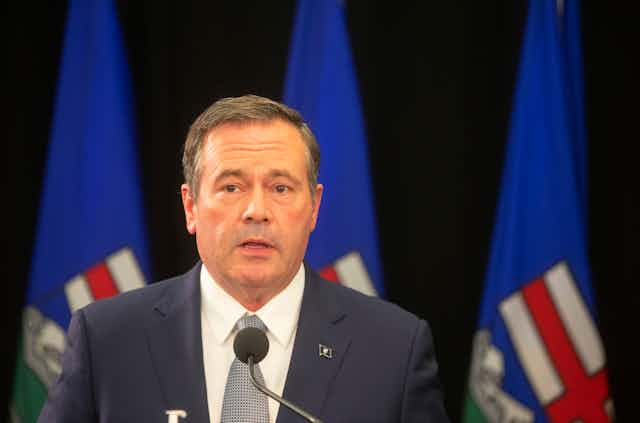The “yes” side won Alberta’s recent referendum to remove equalization from the Canadian Constitution. Under normal circumstances, that would be enough to trigger a new round of negotiations with the rest of Canada.
But the events surrounding the vote cast doubt on both the clarity of the question and the level of public support. And Premier Jason Kenney’s own comments undermine the premise that he is even seeking constitutional reform in the first place.
As he has neither the mandate nor the intent to convene a constitutional conference, the rest of Canada should reject the premier’s invitation. By the Alberta government’s own standards, the results of their equalization referendum fail to meet the criteria necessary to bring premiers and the prime minister to the table.

Three criteria
Kenney states that the referendum results reflect a “clear majority” on a “clear question” and thus represent a “legitimate attempt by one participant in Confederation to seek an amendment to the Constitution.”
He drew these three criteria from what’s known as the secession reference, a Supreme Court decision that his advisers believe forces the rest of Canada to negotiate with Alberta in good faith.
That’s an inaccurate interpretation of the reference, which the Supreme Court justices explicitly confined to votes for independence. Yet there are even larger problems with the Alberta government’s logic.
A clear question, a legitimate attempt?
The wording of the referendum question was direct:
“Should Section 36(2) of the Constitution Act, 1982 — Parliament and the Government of Canada’s commitment to the principle of making equalization payments — be removed from the Constitution?”
In describing the potential outcomes of a “yes” vote, however, the government — and even the provincial election agency — led voters astray.
Despite the actual wording, the premier insists the referendum was never meant to actually change the Constitution. To do so would require the support of a majority of provinces, many of whom receive equalization payments from the federal government.

Instead, the premier said the referendum was intended to put Albertans’ frustrations with Confederation on the public record and provide him with “leverage” to secure a “fair deal” for Alberta.
The fair deal includes changes to a host of federal laws and policies, none of which have anything to do with the Constitution.
This framing undermines the premier’s contention that the referendum was a “legitimate attempt” to spark constitutional change. First ministers should reject the premise of his gambit.
Clear majority?
“Yes” votes outnumbered “no” votes in this referendum. The overall level of popular support for constitutional change is less certain, however, given a very low level of voter participation.
Most estimate the turnout in the referendum at around 40 per cent. If we multiply turnout by the share of all ballots cast in favour of “yes” — 62 per cent of valid votes — we reach a striking conclusion: fewer than one in four of all eligible Alberta voters turned out in favour of removing equalization from the Constitution.
This is a very low level of popular support, even according to the premier’s own standards.
One in four is around the same share of eligible voters who conferred a majority of seats to Rachel Notley’s New Democratic Party in 2015 (23 per cent) — a result Kenney once called “accidental,” implying it was an illegitimate majority.

One in four is also perilously close to the threshold the government recently set for citizens to initiate constitutional referendums of their own accord. According to that legislation, constitutional questions require the signatures of 20 per cent of eligible voters in two-thirds of the provincial constituencies across Alberta to even be considered by the government for a provincial referendum.
Given low levels of turnout and high levels of “no” support in urban areas, it’s unlikely the results of the equalization referendum clear even that low bar.
By the standards of the government itself, this is a weak foundation upon which to build a popular mandate for constitutional reform. But the ultimate decision is not up to them.
Mandate for change?
In citing the secession reference, Kenney notes “it will be for the political actors to determine what constitutes ‘a clear majority on a clear question’” when it comes to the results of constitutional referendums like the one Alberta just held.
Those stakeholders include the prime minister and other premiers, all of whom have good reason to doubt whether the murky messaging, questionable intent and low level of turnout in Alberta are sufficient to convene a constitutional conference on equalization.
In the end, it will be them — not Kenney, pundits, political operatives or academics — who determine whether Alberta has forced them to the table, let alone has the leverage to sell them on a fair deal.
As with the referendum itself, there’s a solid case to say “no.”

